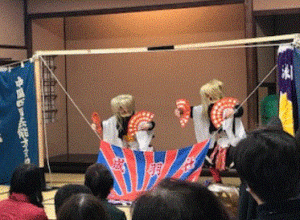What does “Kagura” mean?
The primary meaning of the word “Kagura” is to entertain gods. However over time, more meanings have been added to this word. Now all performances that are dedicated to gods by dancing or playing drama of mythology are called “Kagura”.
”Kagura” is played all over Japan. It means people remember different images of that they are living in. “Kagura” has a rich variety. the characters in it have many types too. Generally, many people remember the performance of playing mythology.
In this site, we mainly focus on masked characters.
We mainly introduce Kagura of Japan.
Hayachine Kagura (早池峰神楽)
We can see this Kagura in Iwate prefecture. This is UNESCO Intangible Culture Heritage.
Originally, ‘yamabushi’ spread it. ‘Yamabushi’ who mainly believe buddhism Taoism, and Shinto, are mountain ascetic hermits.



The home is Hayachine shrine in Hayachine mountain. The main event is held in Hayachine shrine, on 31th ,Jury and 1st of August. This Kagura has many similar performance that are played over Iwate prefecture.
Characteristics of this Kagura is the dance center and has few elements of drama. Tempo is faster in comparison with others. And we can see players set on the floor strongly and sound it with dancing.


reference→ https://planetyze.com/en/japan/iwate/hayachine-kagura
Kanto sato Kagura 関東里神楽
Kanto is a region consisting of seven prefectures include Tokyo, located in the center of Honshu (the largest island of Japan). This Kagura is influenced from Sata shrine’s Kagura in Izumo (Shimane prefecture).

It was then influenced by elements of Noh and Kabuki, and became more diversified. Ritual dance the center of elements, so you might feel formal. But they have elements of comedy. For example, the play about the beginning of rice growing or ‘Ebisu’ (the deity of happiness) will show you an interesting time. They sometimes perform elegantly and other times comically.


Edo sato Kagura 江戸里神楽
Edo is the old name of Tokyo. In Kanto Kagura, they mainly performed in Tokyo in the past and were a group performed. Even now, groups called ‘Shachu’ (a kind of specialist group). They go to shrines to play Kagura on festival days. They bacically play episode of Japanese mythology without words. If you see their play, you will feel elegant and it is similar with Noh.


Ise dai-Kagura 伊勢太神楽
This Kagura originally to went around the country and contributed bill of deity in Ise for people who can’t come to Ise grand shrine. Still now, five groups from Kuwana go around each region (mainly west of Japan). They are literally on a trip everyday. This Kagura has two types of dance, lion dance and entertainment dance.



both pictures from http://www.kandayuyamamoto.jp/info/12-24-kuwanacity-masuda/
Bicchu Kagura 備中神楽
We can see this kgura in Okayama prefecture. Bicchu is the old name of Okayama district.

Originally, this Kagura was the quiet heart of “Koujin” (a god of the land who causing disasersor storm). An exggerated performance similar to comedy routine or a singing performance was inserted into this Kagura. The main part contained on music accompanied by traditional instruments.


Both pictures from https://www.kurashiki-tabi.jp/blog/17216/
Iwami Kagura 岩見神楽
It can be that ‘That’s entertainment’. This Kagura was originally “Ohmoto Kagura” held in Iwami region (the old name of west Shimane prefecture).

From the Edo to the beginning of the Meiji period (first half of the 20th C), many people altered original performance. They changed the rhythm, six tone change to eight tone, clothes become more gogeouss, and the stage direction such as smoke or fireworks was added. If you watch “Orochi” one of most popular program, (Orochi is a dragon like creature), you will experience an unforgettable surprise.


Takachiho Kagura 高千穂神楽
This Kagura is held in Miyazaki prefecture. This region is known as the origin of mythology many places related in the Kagura performance are said to have to taken place here.

Among of the mythology, episode of ‘Amano iwato biraki’ is especially viewed as important. This Kagura is held generally through the night.


Both pictures from http://takachiho-kanko.info/en/news/detail.php?id=34
Today, a digest is held for sightseeing every evening.
